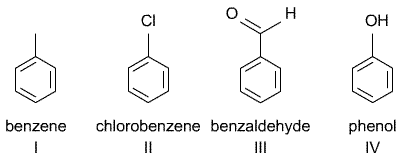12) Tendency to distribute
Question: Rank the four compounds (I − IV) indicated below in the order of increasing tendency to distribute from (a) air into hexadecane (mimicking an apolar environment), (b) from air to olive oil, and (c) from air to water.
|
 |
Answer:
The order of experimental data does not always match the results of qualitative estimates. However, differences in K-values are usually smaller than a factor 3. You cannot expect a qualitative estimation to perform better than that. In addition, please note that a qualitative estimation cannot always be carried out.
air −> hexadecane |
|
The large difference between the partitioning coefficients of benzene and phenol are somewhat unexpected since they have a similar molecular size.
| air −> olive oil |
|
| air −> water |
|
Download this page as a pdf






